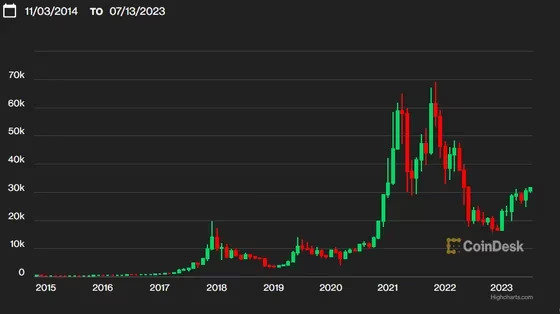
- In 2023, Bitcoin and Ethereum will rapidly decouple from traditional financial instruments.
- While maturing as uncorrelated assets, the number of addresses holding Bitcoin and Ethereum has increased.
If there’s a more surprising market development than Bitcoin (BTC)’s performance in 2023, it might be its decoupling from traditional financial instruments. The loss of correlation with traditional financial instruments will no doubt have both happy and sad investors.
Little response to macro factors
While some investors may appreciate Bitcoin’s ability to weather macro noise, others may lament the lack of regular rallying that accompanies good news.
While bitcoin investors feel comfortable with bitcoin becoming an uncorrelated asset, they also note that it is less responsive to global macro factors than traditional finance (TradFi) assets. had to pay.
Correlations between the S&P 500, Dow Jones Industrial Average, Nasdaq Composite and Bitcoin have fallen to 50.5%, 30% and 49.4% respectively since Jan. 1.
Admittedly, news about digital assets has never been calm. There were regulatory overreach, unsubstantiated rumors about the resignation of the US Securities and Exchange Commission (SEC) chairman, and speculation about the Fed’s policy decisions. However, apart from June 15’s response to the world’s largest asset manager BlackRock’s Bitcoin exchange-traded fund (ETF) filing, bitcoin’s price has been relatively muted.
Bitcoin was in a three-week range trading and low volatility before hitting a one-year high of $31,700 late Monday. Ethereum (ETH) did the same, with investors increasingly willing to settle for year-to-date gains while waiting for new material.
Small macroeconomic impact
At this point, the macroeconomic factors that drive the market as a whole appear to have relatively little impact on Bitcoin. Decoupling, on the other hand, is not limited to equities.
The correlations between Bitcoin and gold and the US dollar are 0.33 and -0.23 respectively. Both are close to zero, meaning there is no correlation between price movements. Ironic given that Bitcoin was initially perceived as an inflation hedge.
Ethereum has the most consistently positive correlation with Bitcoin. Despite the differences in utility and consensus algorithms between the two assets, they have moved relatively in sync.
number of addresses increased
The independence of Bitcoin and Ethereum suggests that the asset is maturing, and any developments specific to that asset will result in a sharp move.
Bitcoin and Ethereum’s little reaction to yesterday’s solid inflation report shows that most investors are trying to avoid the noise. It seems that they are quietly buying more than wild speculation.
Since January 1, the number of Bitcoin addresses with non-zero balances has increased by about 9%, according to research firm Glassnode. Ethereum saw a similar increase of 11%.
As for bitcoin, it continued to rise despite its price dipping to $25,000 in May, suggesting stable demand is underpinning it.


|Translation: CoinDeskJAPAN
|Editing: Rinan Hayashi
| Image: CoinDesk
|Original: Bitcoin, Ether Maintain Their 2023 Decoupling from Traditional Finance
The post Bitcoin and Ethereum maintain decoupling from traditional financial products | CoinDesk JAPAN | CoinDesk Japan appeared first on Our Bitcoin News.

 1 year ago
89
1 year ago
89














 English (US) ·
English (US) ·